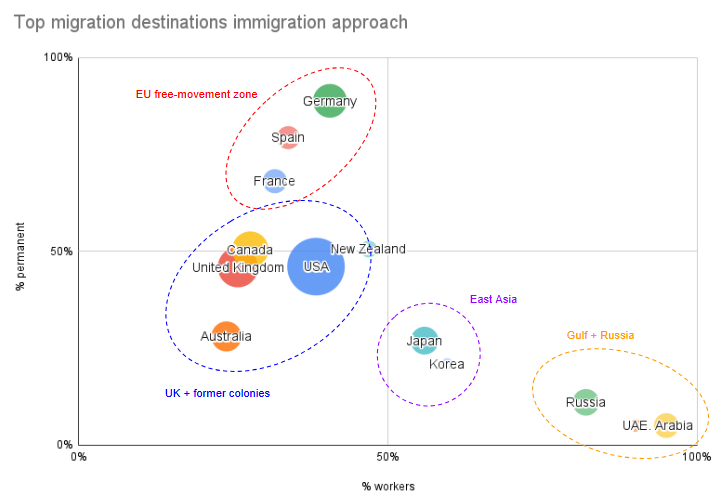A Map of Migration Policy Priorities
I’m trying to get my head around global migration.
Where do people move from and where do they go? Why?
How do countries prioritize different types of immigrants? And what can different systems learn from each other?
All of this with an eye towards informing where I, and others trying to do good in the space, should focus our energy.
At a basic level, a country that accepts immigrants has two big decisions to make.
Do we want people to stay permanently, or just temporarily?
What role will migrants play here? (working, accompanying family, studying, seeking refuge)
Below is my attempt to map how the world’s top immigration destinations have answered these two questions:
Up is permanent migrants, down is temporary. Right is work-driven migrants, left is not (family, students, refugees). Size of bubble is how many migrants accepted per year (1)
Some very brief insights:
There are four clear clusters in how the top countries approach immigration:
EU free-movement zone: Citizens from any EU country can move and settle permanently. These countries have high permanent migration but not all of it is for work — many movers come for family or retirement.
UK and former British colonies: Relatively balanced systems with a strong focus on skilled migration, but with lots of temporary work visas, student visas, and family-based pathways.
East Asia: Japan and Korea focus on temporary workers to support their aging demographics
Gulf + Russia: Autocracies who have a large amount of circular migration - the gulf from South Asia, and Russia from former Soviet neighbors.
Countries accepting of permanent migration tend to have less work-related immigration. Presumably one of the reasons is because when people want to move a place permanently, they want to bring their (potentially non-working) family.
East Asia takes in way more migrants than I had thought.
Next time I’ll double click into labor mobility specifically.
—
1. My data here comes from the OECD data explorer (permanent, temporary) for 2022. They . For Russia, the UAE and Saudi Arabia, data was harder to find, so take these with a grain of salt.
